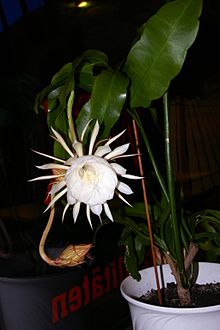Epiphyllum
| Epiphyllum | |
|---|---|

| |
| Epiphyllum oxypetalum | |
| Scientific classification | |
| Kingdom: | Plantae |
| Clade: | Tracheophytes |
| Clade: | Angiosperms |
| Clade: | Eudicots |
| Order: | Caryophyllales |
| Family: | Cactaceae |
| Subfamily: | Cactoideae |
| Tribe: | Hylocereeae |
| Genus: | Epiphyllum Haw. |
| Type species | |
| Epiphyllum phyllanthus | |
| Species | |
| Synonyms | |
Epiphyllum (/ˌɛpɪˈfɪləm/;[2] "upon the leaf" in Greek) is a genus of epiphytic plants in the cactus family (Cactaceae), native to Central America and South America. Common names for these species include climbing cacti, orchid cacti and leaf cacti, though the latter also refers to the genus Pereskia.
The stems are broad and flat, 1–5 cm broad, 3–5 mm thick, usually with lobed edges. The flowers are large, 8–16 cm diameter, white through red, with numerous petals. Flowers bloom only at night, and wilt at dawn. The fruit is edible, very similar to the pitaya fruit from the closely related genus Hylocereus, though not so large, being only 3–4 cm long. The broad-leaved epiphyllum (Epiphyllum oxypetalum) is particularly well-known. It bears large, strongly fragrant flowers that each usually open for a single night only.
The plants known as epiphyllum hybrids, epiphyllums or just epis, which are widely grown for their flowers, are artificial hybrids of species within the tribe Hylocereeae, particularly species of Disocactus, Pseudorhipsalis and Selenicereus. In spite of the common name, Epiphyllum species are less often involved as parents of epiphyllum hybrids.[3]
Extant species[]
As of May 2020, Plants of the World Online accepts 10 species:[4]
| Image | Scientific name | Distribution |
|---|---|---|
 |
Dorsch | Colombia, Panama |
| (F.A.C.Weber) Britton & Rose | Costa Rica, Panama | |
| Alexander | ||
| (F.A.C.Weber) Britton & Rose | Costa Rica, Nicaragua, Panama | |
 |
Epiphyllum hookeri Haw. | Mexico, Central America, Venezuela; introduced to Florida |
 |
Epiphyllum laui Kimnach | Mexico |
 |
Epiphyllum oxypetalum (DC.) Haw. | Belize, Honduras, El Salvador, Mexico |
 |
Epiphyllum phyllanthus (L.) Haw. | Mexico to Venezuela then south to Argentina |
 |
Epiphyllum pumilum Britton & Rose | Guatemala, Mexico |
| (K.Schum.) Britton & Rose | Costa Rica, Ecuador, Guatemala, Nicaragua |
Formerly placed here[]
- Disocactus crenatus (Lindl.) M.Á.Cruz & S.Arias (as Epiphyllum crenatum (Lindl.) G.Don)
- Disocactus phyllanthoides (DC.) Barthlott (as E. phyllanthoides (DC.) Sweet[5])
References[]
- ^ "Genus: Epiphyllum Haw". Germplasm Resources Information Network. United States Department of Agriculture. 2004-02-13. Archived from the original on 2012-10-11. Retrieved 2011-04-14.
- ^ Sunset Western Garden Book, 1995:606–607
- ^ Anderson, Edward F. (2001), The Cactus Family, Pentland, Oregon: Timber Press, ISBN 978-0-88192-498-5, p. 286
- ^ "Epiphyllum Haw". Plants of the World Online. Royal Botanic Gardens, Kew. Retrieved 2020-05-15.
- ^ "GRIN Species Records of Epiphyllum". Germplasm Resources Information Network. United States Department of Agriculture. Archived from the original on 2012-12-12. Retrieved 2011-04-14.
External links[]
| Wikimedia Commons has media related to Epiphyllum. |
| Wikispecies has information related to Epiphyllum. |
- Epi Species (GotEpis.com), a comprehensive list of genera of epiphytic cacti.
- Epiphyllum
- Night-blooming plants
- Epiphytes
- Cactoideae genera